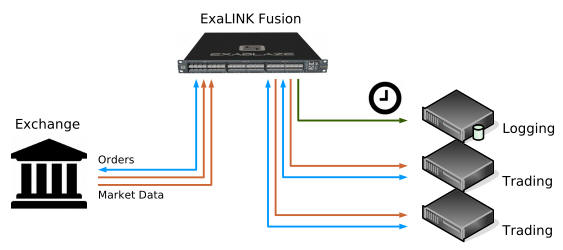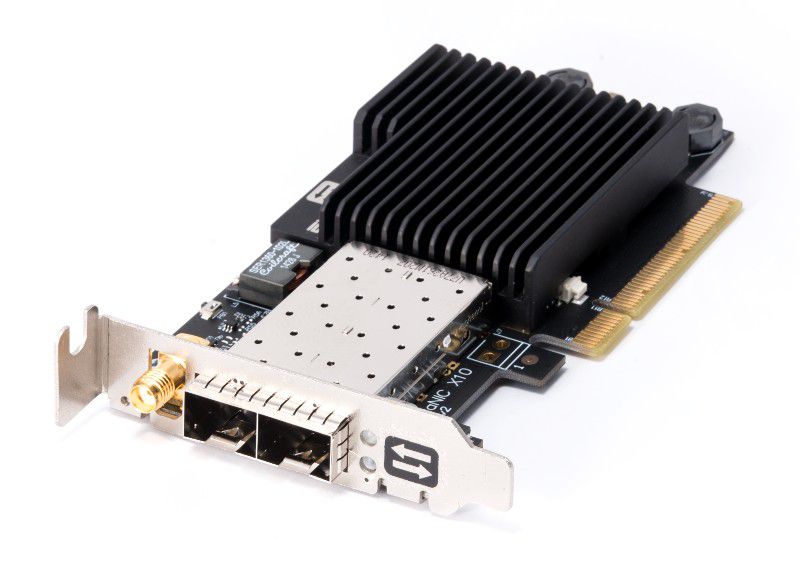
(A) Extra Low Latency Switch
 Patch and Tap
Patch and Tap
5 nanoseconds tapping and patching. Dynamically tap the feed on any input or output to any other port, replacing conventional optical taps. Dynamically patch any port to any other port to create bidirectional layer 1 links. Clock and data recovery circuitry ensures signal integrity is maintained throughout your network.
 Aggregate
Aggregate
49 nanosecond aggregation. Aggregate multiple streams with extremely low and deterministic latency by bypassing MAC address lookups, sharing a single network resource fairly. Optionally, use layer 1 on the return path to further reduce latency and jitter and guarantee response times.
 Switch
Switch
95 nanoseconds port to port latency with full layer 2 switching. The industry's lowest latency cut-through layer 2 switch. Supports ultra-low latency multicast and broadcast.
 Redefine
Redefine
It's your network, build it your way. The modular ExaLINK Fusion can be shipped with a Xilinx Ultrascale FPGA module that allows you to completely redefine the way your network operates. The layer 1 technology in the Fusion allows you to create dynamic circuits between any and all front panel ports and the FPGA. Build custom packet processing engines. Filter traffic. Switch based on packet content. Experiment with new protocols. The Fusion makes all of this and more possible.
USE CASE

(B) Extra Low Latency NIC
ULTRA LOW LATENCY NETWORK INTERFACE CARD
The ExaNIC is a 10Gbps PCI
Express network card interface card specifically optimized for
low latency environments. While initially conceived and built
for use in latency-sensitive financial applications such as high
frequency trading, the ExaNIC has appeal that extends to any
environment where latency is key.
INDUSTRY-LEADING LATENCY
Designed from the ground up
to minimize latency, the ExaNIC delivers record-breaking
performance numbers. On an Intel Ivy Bridge test system, median
latency from application to network to application is 780
nanoseconds for small packets, which is significantly better
than competing network cards on the same hardware. Half round
trip TCP latencies are as low as 930 nanoseconds for small
payloads.
EASY TO USE
In addition to a standard
Linux driver, a transparent TCP and UDP acceleration library is
included, as well as a library for low-level access. A
transparent socket acceleration library allows applications to
benefit from the low latency of kernel bypass, in most cases
without modifications to the applications. For the most latency
sensitive applications, a library called "libexanic" allows
direct low-level access to the ExaNIC hardware and includes
simple functions for sending and receiving Ethernet frames. With
the optional firmware development kit, it is even possible to
extend the ExaNIC firmware and add your own logic to the onboard
FPGA.
ADVANCED CAPTURE AND TIMESTAMPING
Flow steering delivers
packets to the right application's receive buffer, while flow
hashing distributes packets across multiple CPU cores for
demanding capture applications. Built-in timestamping
functionality records each frame's arrival time to a granularity
of 6.2ns. These timestamps are available through the API and
through a capture utility which can write tcpdump-compatible
capture files. Additionally, the ExaNIC has a Pulse-Per-Second
(PPS) input which can be used to synchronize the ExaNIC clock
with a PPS source such as a GPS receiver, allowing users
to meaningfully compare captured timestamps across multiple
servers and geographic locations. The PPS input can also act as
a PPS output for instances where one ExaNIC should act as the
PPS source for other devices in a rack.
BUILT-IN BRIDGING
The ExaNIC includes
integrated support for bridging, which can further reduce
latency by hundreds of nanoseconds. Normally sharing an upstream
connection between multiple servers would necessitate
introducing a switch. The bridging feature allows the most
latency critical server to be directly connected to the
upstream connection. Packets not destined for the local server
can be bridged to the second port, transparently and with low
latency. This port could be connected to a backup server or to a
downstream switch.







